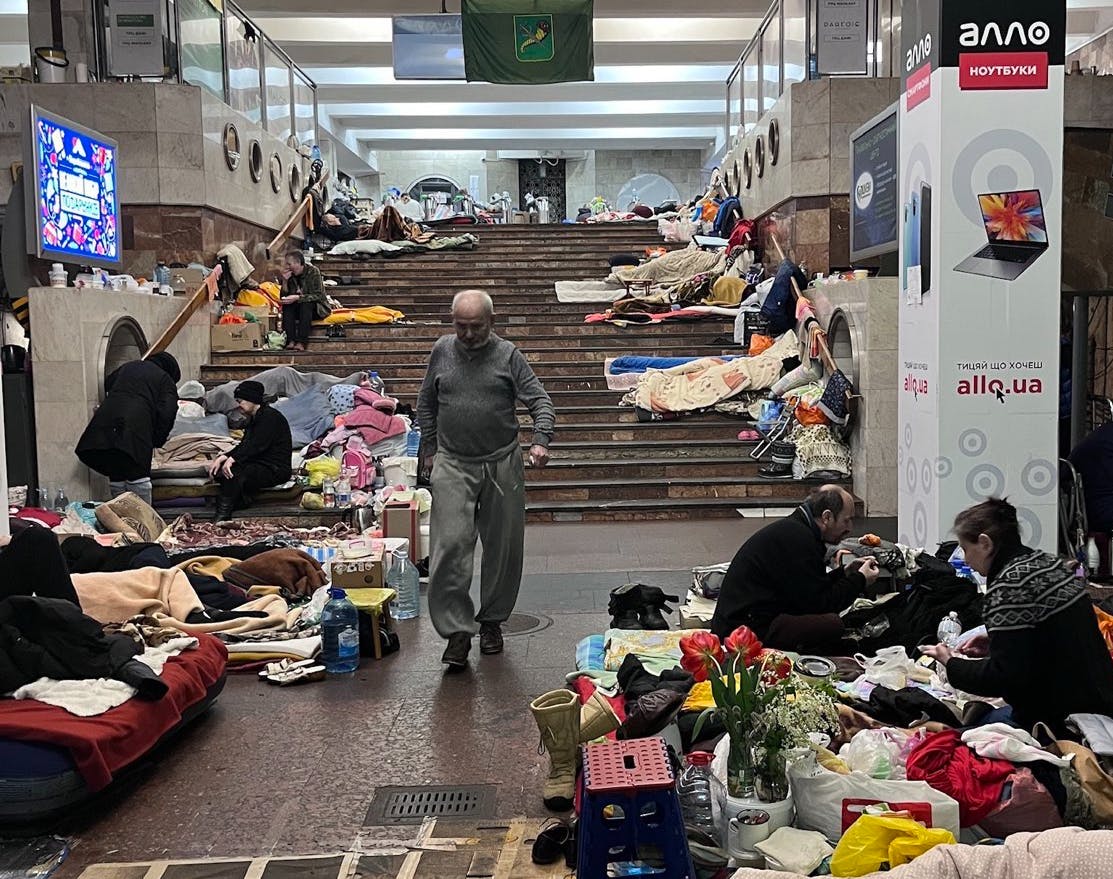Notes From the Kharkiv Underground
The subway’s surfaces aren’t damp, but a thick humidity is chokingly palpable. The air tastes and smells like the collective exhale of hundreds of people.

KHARKIV, Ukraine — Only those too infirm or without the means to leave their homes are bearing witness to Kharkiv’s blooming springtime outside their windows. Many residential streets are empty, vaguely reminiscent of some post-apocalyptic film.
Beside the sounds of outgoing Ukrainian ordnance and impacts of Russian artillery, large swaths of the city are eerily still. Belowground, however, the subway system is teeming with life.
Kharkiv’s protective subterranean beehives are hidden from Russian forces implanted in dug-in positions on the city’s outskirts, and the metro’s residents have been here from virtually the first day of this conflict.
Olya, a 29-year-old volunteer who carves a measure of order in Kharkiv’s cavernous metro stations, explains that many people “were scared and lost,” which motivated her to do what she could “to make them feel at least a bit better.”
She is one of Kharkiv’s metro station heroes, helping the people living there find medicine, clothing and blankets, and food.
Although some Russian units pushed briefly into the city center in late February, their success was short-lived. Driven to Kharkiv’s outskirts, Russian forces fought a pitched but ultimately unsuccessful last stand at School Number 134. Now they pound the city daily with a variety of heavy and indiscriminate ordnance.
The campaign of terror chips away at Kharkiv’s homes but has also injected a measure of steel into the average Kharkivite’s psyche — a not insignificant number would rather live in the subway stations than leave their city.
Out of an abundance of caution, and prompted by recent strikes near stations following visits by reporters, Ukrainian Territorial Defense Forces expressly bar publishing the names of metro stations.
Although Kharkiv’s metro stations are not as deep underground as Kyiv’s — those were designed to protect city residents from nuclear warfare — the descent into one metro station is entering a divergent reality.
The subway’s surfaces aren’t damp, but a thick humidity is chokingly palpable. The air tastes and smells like the collective exhale of hundreds of people.
Dozens are sprawled across the metro stairs and platform and peer out from bundled winter clothing. Several older people lay on homemade mattresses made of flattened cardboard, rugs, and blankets. Many have hacking coughs.
The station volunteers explain that some underground residents suffer from pneumonia-like symptoms, adding that any concern about Covid melted away in the face of more immediate health concerns. Keeping warm — and dry — has been difficult.
Common health issues include heart problems and high blood pressure brought on by stress as well as diarrhea and vomiting, exacerbated by daily shelling.
Potable water is piped into the station and through the platform for the station’s residents. Although small, there are two bathrooms, one for men and another for women.
Functional plumbing is a boon but water pools below the platform and in the bathrooms, providing a fertile breeding ground for the mosquitos the passengers lethargically swat.
The station has its own infirmary, a small storage closet with shelves crammed full of medical supplies. A physician there attends to an older woman, changing a leg bandage and cleaning the underlying wound.
The sickbay is relatively well-stocked, the physician explains. However, their most pressing need now is powerful liquid antibiotics that are in short supply and hard to source.
The metro station’s social hierarchy is based partly on date of arrival, and partly on an individual’s contribution to the station. Volunteers visit most stations daily but rely partly on help from residents for tasks like cooking and cleaning.
Julia, though just 36, has more seniority than most. She and her two children left their home at Bolshaya Danilovka at the city’s northwest outskirts during the early morning hours of February 24.
Their neighborhood became part of the front line, and the fighting destroyed the family’s apartment — they stay underground because they have no home to go back to. Julia proudly stands in front of Wagon 3, Door 2. It’s their new address, she explains.
Because they fled to the station on the first day of Russia’s renewed invasion, the family secured a rare and coveted place onboard one of the subway carriages parked at the subway platform.
Their wagon isn’t much, but it affords the small family a measure of privacy their neighbors on the platform don’t enjoy. Nestled among blankets, suitcases, and drying laundry, their wagon neighbor’s children peer out the window at the platform.
Sleeping in a wagon provides other advantages beside privacy. With the doors closed, the wagons offer passengers some respite from the hubbub on the platform.
The wagons are warmer too. Today, the subway station’s ambient temperature is cooler than the warm spring air outside, but in late February it was freezing.
Brightened by fluorescent lighting, the passengers settle into a monotonous pattern of life. In the dim, flickering half-dusk, the time of day has almost entirely lost its pre-war importance.
Passengers place a premium on finding respite, however brief, from the daily belowground grind. Although alcohol is forbidden below the surface, sobriety is a tall order.
The rule lacks an enforcement mechanism and is occasionally broken from inside subway wagons and on the platform. But, the volunteers explain, as long as the passengers don’t become loud and unruly, they’re forgiven for furtive pulls from hidden bottles.
Gallina, a 61-year-old-Kharkivite, isn’t much of a drinker. Instead, she finds respite from the reality of living in a subway station in service to her underground neighbors.
A physics and math teacher by training, Gallina stakes her claim to a mattress-sized spot on the platform floor that she shares with Remus, an 8-year-old hairless Sphinx cat.
For three weeks, Gallina lived with her two grandsons and daughter-in-law in their apartment building basement before coming to the metro station. At the time there was snow on the ground, giving the family a reliable water source.
A group of volunteers organized their evacuation via van. The driver told them to stay on the floor and not to look outside on their way out. But, Gallian explained, she peered out the window.
Through tears, Gallina recounted their escape. She saw “bombed cars and parts of bodies” littered across the road.
When she came to the station, Gallina wanted to do something with her time and “needed a distraction.” The kitchen didn’t need her, but she found she could be useful cleaning the station toilets thrice daily.
Gallina’s work is rewarded by the thank-yous of other passengers, which for her is “like a hug” and makes her feel both needed and busy.
She also tries to give children math and physics lessons, though she notes that many subway children seem to enjoy their underground holiday rather more than learning mathematical skills.
Scratching Remus’s chin, Gallina explains that life at the station has occasional perks. There is food every day and “sometimes better food” than what Gallina ate before the war.
The passengers particularly appreciated a shipment of canned tuna, food they’re unaccustomed to eating. And, Gallina notes appreciatively, there is plenty for her cat.
Not all passengers are quick to trust, the volunteers explain, adding that the passengers accuse volunteers of withholding the best food donations for themselves — an accusation without any merit, the volunteers note.
The subway children concur with Gallina. Their life underground is a perpetual playdate, interspersed with art therapy sessions organized by volunteers and nearly daily treats from off-duty soldiers.
Although parts of the passengers’ day-to-day lives are jolly, the rationale behind why they choose to stay is decidedly more serious.
One of the subway’s wartime passengers, Natalia, explained that “Kharkiv is important” because both her “daughters were born here.” Her husband Sergey is fighting somewhere near the front.
Nodding at her girls, 11 and 15 years old, she explains that come what may, they will “stay and pray for our soldiers” and “pray for our city” from their underground home.

